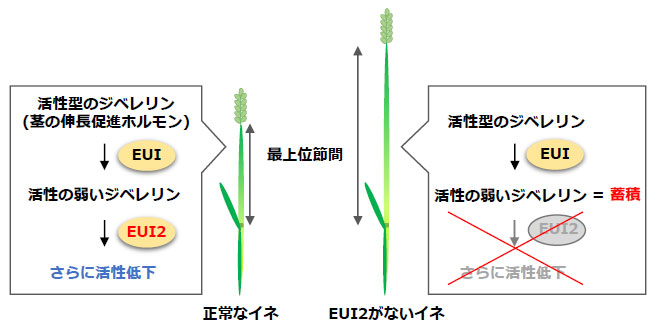2025-06-05 京都大学

イネの最上位節間おけるジベレリンの段階的な活性調節とEUI2の働き
<関連情報>
- https://www.kyoto-u.ac.jp/ja/research-news/2025-06-05
- https://www.kyoto-u.ac.jp/sites/default/files/2025-06/web_2506_Mashiguchi-ced3d18a6d20a1b0a284e4d7e817b10c.pdf
- https://www.pnas.org/doi/10.1073/pnas.2415835122
イネ節間伸長におけるジベレリンの段階的不活性化 Stepwise deactivation of gibberellins during rice internode elongation
Toshiaki Ishida, Yingying Zhang, Hongbo Zhu, +7 , and Shinjiro Yamaguchi
Proceedings of the National Academy of Sciences Published:June 4, 2025
DOI:https://doi.org/10.1073/pnas.2415835122
Significance
Plant hormones play an essential role in almost all aspects of plant growth and development. Their endogenous levels should be tightly regulated by both biosynthesis and deactivation to maintain their cellular homeostasis. Here, we show that the sequential action of a cytochrome P450 monooxygenase EUI and an epoxide hydrolase EUI2 is critical for the deactivation of a diterpenoid hormone, gibberellin, in rice internode elongation. Moreover, we found that an enzymatic product of EUI has a weak but significant biological activity. Our findings will broaden our understanding of how plant hormones are precisely deactivated. In addition, our results suggest that a weakly active hormone may play a physiological role in fine-tuning various developmental processes.
Abstract
Bioactive gibberellins (GAs) are a class of plant hormones that regulate various aspects of plant growth and development, and several key GA deactivation enzymes have been identified. In rice, non-13-hydroxylated GAs have been shown to be deactivated via 16α,17-epoxidation by a cytochrome P450 monooxygenase, ELONGATED UPPERMOST INTERNODE (EUI/CYP714D1). Although 16,17-dihydro-16α,17-epoxyGA4 (16α,17-epoxyGA4), the product of EUI from bioactive GA4, has shown weak bioactivity on rice seedlings, how 16α,17-epoxyGAs are further deactivated remains elusive. Here, we identify the EUI2 gene, which regulates internode elongation in rice, using a map-based cloning strategy. EUI2 encodes an epoxide hydrolase that hydrolyzes 16α,17-epoxyGAs to 16,17-dihydro-16α,17-dihydroxyGAs. The eui2 mutants are taller than wild-type plants but are shorter than the eui mutants. However, the levels of known bioactive GAs in the uppermost internodes are not significantly increased in the eui2 mutants. Instead, we show that the eui2 mutants accumulate 16α,17-epoxyGA4 to high levels. We also show that exogenously applied 16α,17-epoxyGA4 is significantly active in elongating the uppermost internode, although not as potent as GA4. Furthermore, we demonstrate that 16α,17-epoxyGA4 can directly interact with the rice GA receptor, GIBBERELLIN INSENSITIVE DWARF1, in vitro. Taken together, the sequential action of EUI and EUI2 results in the stepwise deactivation of GAs during internode elongation in rice. Our data also suggest that the accumulation of a weakly active GA contributes to the mildly tall phenotype of the eui2 mutants.



